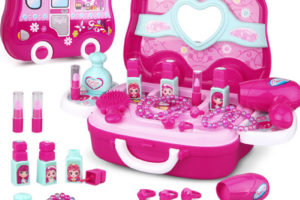As a paediatric allergist I am constantly answering questions from friends, relatives, patients and colleagues about introducing allergens to babies. Many people have heard that it’s important to introduce them early, but aren’t clear on exactly why or how to do so.
I strongly encourage early introduction of the major allergens, including milk, eggs, peanuts, tree nuts, wheat, soy, fish, shellfish and sesame into your baby’s diet, as this is the best way to decrease their risk for developing food allergies. As a mom, I know this can feel overwhelming, but it doesn’t have to be. Here are some tips for how to safely introduce allergens to babies.
When should you introduce allergens to babies?
The Canadian Paediatric Society (CPS) and Canadian Society for Allergy and Clinical Immunology (CSACI) recommend introducing allergens to all infants at around six months but not before four months. This recommendation especially applies to peanut butter and egg, since evidence supports introducing these allergens early in life to help prevent the development of allergies.
Since there are nine major categories of allergens, it poses quite a challenge to introduce all of them around six months, therefore, practically, many allergists recommend starting allergen introduction between four to six months of age. Personally, I introduced solids for both my daughters at four months, allowing ample time to introduce allergens alongside complementary foods, such as iron-rich foods, fruits and vegetables. I was breastfeeding at the time and continued to do so; introducing solids did not interfere with this.
Is introducing allergens important for all babies?
In my clinical experience, many families don’t feel the need to introduce allergens early because they feel that their child is at low risk for developing food allergies. I often hear that “food allergies don’t run in our family”. While I wish it could be that simple, unfortunately, it’s not. According to the Canadian Paediatric Society, an infant is considered to be at high risk for developing food allergies if the infant himself has allergies or eczema, or if there is an immediate family member with an allergic condition. For example, an infant whose sister has asthma is high risk; an infant whose parent has seasonal allergies is also high risk. Bottom line—your baby’s risk may be higher than you think. Food allergy can also develop even in babies with no risk factors.
How to introduce the top allergens
First, let me be clear: Introducing allergens means that your baby needs to be eating the allergenic food—not rubbed on the cheek or lip. It is not recommended (and potentially harmful) to apply foods onto your baby’s skin before feeding them.
When it comes to introducing the major allergens, there is no particular order that needs to be followed. However, because most of the evidence for early introduction stems from studies conducted with peanut butter and egg, I tend to recommend introducing these first.
While I recommend only introducing one major allergen at a time, the traditional advice of waiting three days between introducing new foods is not evidence-based and may unnecessarily prolong the introduction of new foods. It’s important to note that oils (eg. peanut oil, almond oil, sesame oil) do not contain enough protein and therefore, do not count as sufficient allergen exposure. When introducing allergens (and solid food in general) avoid hard or chunky foods, as they are choking hazards. Also, avoid any raw or undercooked foods (e.g. raw eggs, fish or shellfish) and unpasteurized dairy.
Once an allergen is introduced, it is important to maintain it in your baby’s diet on a regular basis. How often? The truth is, we don’t know the precise answer to this, although giving less often than once per week may be ineffective. Ideally, I recommend two to three times per week to start, though this can be more challenging once you have introduced multiple allergens. In that case, I suggest aiming for at least once per week.
Peanut
- Do not feed whole peanuts as they are a choking hazard
- Peanut butter from the jar is too thick for babies, so you can dilute smooth peanut butter with hot water (then cool before feeding it on a spoon), breast milk, formula, or fruit purees and feed it on a spoon. (If you have peanut flour or peanut butter powder on hand, this works too.)
- Peanut puffs (eg. Bamba Peanut Snack) are also an easy way to introduce peanuts to a baby, although they should be softened if your baby is under 7 months.
Egg
- Egg white and yolk can be introduced together. There is no advantage to introducing these separately
- Offer your infant tiny, soft pieces of scrambled egg. It can sometimes take babies a few tries to get used to the texture of the egg so if they don’t like it the first time, keep trying.
- Cooked scrambled egg can also be pureed with breast milk, formula, water, or even a fruit or vegetable puree.
- Another great option is a hard boiled egg, either mashed or blended with water, breastmilk or a puree and fed on a spoon.
Milk
- If your baby is being fed with a cow’s milk-based formula, then they are already being exposed to cow’s milk. If used in early infancy, continuing cow’s milk formula in small amounts daily was shown in recent research to prevent cow’s milk allergy, whereas stopping it increased the risk of developing cow’s milk allergy.
- Many common baby cereals will list ‘skim milk powder’ as an ingredient and can be used to introduce milk. However, if you have not introduced wheat yet, choose an oat or rice cereal that does not contain wheat.
- Yogurt or cottage cheese are also great (if a bit messy!) ways to introduce milk.
- Note that up until 9 months of age, babies should drink either breast milk or formula. Around 9 to 12 months of age, it is okay to introduce homo milk.
Soy
- Many families use soy sauce in cooking, but it does not contain enough soy protein to be considered an introduction and it’s also high in salt
- You may see soy lecithin on an ingredient list for things like baby cereals and formula, but it also does not count as a soy exposure
- Serve extra soft tofu – on its own, or blended with other fruit/vegetable purees.
- Steam and puree edamame and feed on a spoon.
- Serve soy yogurt, mixed with a fruit puree if you’d like.
Wheat
- You can introduce wheat by feeding baby cereals containing ‘wheat flour’—however, avoid those with skim milk powder in the ingredients unless your baby is already tolerating dairy.
- Your baby can eat cooked soft pasta but keep in mind some sauces, particularly tomato sauce, can sometimes cause redness/irritation of the skin (this is not an allergy and isn’t a concern)
- Pancakes (if the other ingredients such as egg and/or dairy have already been successfully introduced).
Tree nuts
- Tree nuts are the most daunting allergen to introduce because there are so many of them, and introducing one doesn’t count as an introduction to all. The main tree nuts that allergists recommend to introduce include almond, cashew, pistachio, hazelnut, walnut, and pecan.
- Other tree nuts that you can consider introducing early are: Brazil nut, Macadamia nut and pine nut (which is technically a seed). However, allergy to these specific tree nuts is relatively rare, so some allergists feel that they do not need to be prioritized.
- There is no particular order that tree nuts need to be introduced. However, when my patients ask for more specific guidance, I usually recommend prioritizing (in no particular order) cashew, hazelnut and walnut, as allergy to these is more common. Fun fact: cashew is closely related to pistachio, so by eating cashew regularly, your child will also gain protection against developing a pistachio allergy. Similarly, walnut is closely related to pecan, so by eating walnut regularly, your child will also gain protection against developing a pecan allergy.
- Introduce them using smooth nut butters (eg. almond butter, cashew butter, hazelnut butter) – these need to be diluted similar to peanut butter, above.
- You can also grind the tree nuts into a fine flour-like consistency – be careful to check for any chunks, which would be a choking hazard. This can be mixed with cereals, yogurts (if dairy has already been introduced), smoothies, fruit purees, etc.
- Once you’ve had a chance to introduce the tree nuts individually, the best way to maintain them in your baby’s diet is by using a mixed nut butter or ground tree nuts combined with yogurt, cereal, fruit/vegetable purees, smoothies, baked goods and in sandwiches (for older children).
Fish
- It is impossible to introduce every type of fish, so I encourage families to introduce a variety of fish, specifically ones that the family enjoys to eat. For those seeking an easy ‘rule’ on what to prioritize, I tend to recommend salmon, canned tuna and a white fish.
- Serve small pieces/flakes of soft, cooked fish
- For younger babies, steamed fish can be blended with other vegetables- for example, I like to steam salmon and potato and then blend them together for my 5 month old daughter.
- Light canned tuna is the preferred form of tuna according to the FDA (due to concern regarding mercury levels in other forms of tuna, such as Albacore tuna). Some experts recommend waiting until your baby is at least six months before serving tuna because of mercury levels. Avoid the highest mercury fish such as shark, swordfish and marlin.
- Always make sure all bones have been removed from the fish prior to feeding.
Shellfish
- If shellfish is not a part of your family’s diet (for religious, cultural or other reasons), don’t worry about introducing it, especially if you’re only going to feed it once or twice as that will be ineffective. If shellfish is a part of your family’s diet, it still may be difficult and not always practical to give every type of shellfish to your infant. From an allergen standpoint, I recommend that patients focus on at least one crustacean (shrimp, crab, lobster) and one mollusk (eg. clam or scallop)
- Since shellfish can be a bit trickier for a baby to eat, I usually save this allergen for last once my baby has had more practice with eating.
- Options include steamed shrimp, cut into tiny pieces or blended with a vegetable puree or small pieces of soft, cooked lobster tail or scallop
- Your baby might enjoy lobster bisque or clam chowder, assuming other ingredients such as dairy have already been introduced (be sure to avoid large chunks)
- Crab cakes, assuming other allergenic ingredients have been introduced, are another option.
Sesame
- Hummus is a safe, healthy and delicious way to introduce sesame. Note that some children can develop contact/irritant reactions from the lemon juice, salt and garlic, but this is not an allergy
- Tahini can also be given plain although not all babies enjoy the taste, in which case it can be blended with fruits or inside a smoothie.
- Sesame oil and sesame seeds often do not contain sufficient sesame protein to count as a sesame exposure.
What about baby-led weaning?
Unpopular opinion: I am not the biggest fan of baby led weaning (BLW). Since BLW encourages self-feeding with finger foods, it tends to start at age 6 months. It is felt that this approach can have many benefits – including self-feeding skills, fine motor skills, and exposure to different tastes and textures. However, as an allergist, my main issue with BLW is that it is not always conducive with introducing allergens early. Additionally, self-feeding leads to more food being smeared on the skin, which can sometimes cause irritation that is mistaken for food allergy and often confusing. So, for the BLW fans, I’d like to offer a compromise: Consider starting solids (including allergens) between four to six months in a baby-safe format, which may not always include finger foods (and that’s okay!). Especially for the common allergens, strongly consider feeding these foods with a spoon for the first several weeks, so you don’t mistake irritation from smeared food as an allergic reaction. When your baby reaches six months or is more developmentally ready for finger foods, you can transition to Baby Led Weaning. Babies can still learn self-feeding skills from eating purees. My little ones loved to suck their fingers and enjoyed trying to feed themselves with a soft baby spoon.
What are the symptoms of an allergic reaction?
The vast majority of allergic reactions will occur within two hours of consuming the food. Symptoms include hives, swelling (eg. swollen lips, swollen skin around the eyes), vomiting, abdominal pain, coughing, wheezing, hoarse voice or hoarse cry, irritability and lethargy.
The good news: the risk of a severe reaction when infants eat a food for the first time is extremely low. As well, anaphylaxis in infants tends to be milder compared to anaphylaxis in older children. All the more reason to introduce allergens when your kids are infants.
Remember, babies can get rashes for lots of different reasons, most commonly in association with a viral illness. Don’t assume that every rash is a food allergy—especially if the rash lasts for more than a day, if the rash came on randomly (rather than within two hours of eating an allergen), or if your baby has been experiencing infectious symptoms such as fever, runny nose or cough.
Also some rashes are nonallergic contact reactions. If your baby develops flat or dry redness of the skin that is isolated to areas where the food contacts the skin (e.g. around the mouth or chin), this might be what we call a contact or irritant reaction. This is NOT an allergy, but can sometimes be mistaken for one. The difference is that contact reactions are not harmful, and you do not need to avoid these foods. If you are unsure, take photos and check with your physician. If your baby has eczema or sensitive skin, you can consider applying a protective barrier to the skin before feeding new foods. I like to use Vaseline for this purpose and apply it around the lips, cheeks and chin, before and after feeding. Eliminating foods from your baby’s diet for the purpose of treating eczema is strongly discouraged—in the long term, this may increase your baby’s risk for developing anaphylaxis to those same foods.
What do you do if your kid has an allergic reaction?
If there are any concerns for severe allergic symptoms call 911 and seek immediate medical attention. If your child already has known food allergies and carries an epinephrine autoinjector, this should be administered without delay.
For mild symptoms, it is recommended to monitor your child very closely and have a low threshold to seek medical attention if any further concerns develop. Consider taking photos of any skin reactions. Avoid the specific food that was consumed until you have a chance to speak with your physician.
It is important to note that epinephrine is the only life-saving treatment for a severe allergic reaction. Benadryl (diphenhydramine) is not recommended, because it often causes drowsiness, which is difficult to differentiate from drowsiness associated with a severe allergic reaction.
Melanie Conway is a paediatrician, paediatric allergist, and a mom with two girls, Rebecca (2.5 years) and Freya (5 months).

































